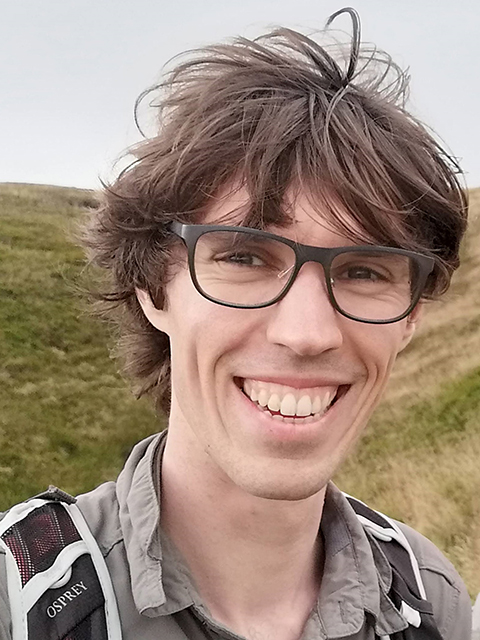Tom has been a Lecturer in Geography at Loughborough since 2024. His work explores the environmental prevalence, pathways, and impacts of material pollution, with a focus on aquatic environments.
Tom’s work lies at the interface of Human and Physical Geography, and he collaborates with scholars across multiple disciplines to explore environmental challenges utilising interdisciplinary methods and partnerships spanning Design, Forensic Science, Engineering, and Arts disciplines.
His research and teaching addresses human impacts on the environment, environmental monitoring, community-integrated environmental science, environmental policy and legislation, and research communication.
Academic Career
- 2024 – present: Lecturer in Geography, Loughborough University
- 2022 – 2024: AXA Research Fund Fellow, Loughborough University
- 2022: Vice Chancellor’s independent Research Fellow, Loughborough University
- 2021 – 2022: Assistant Professor in Freshwater Science, University of Nottingham School of Geography
- 2020 – 2021: Lecturer in Environmental Science, Nottingham Trent University School of Animal, Rural and Environmental Science
- 2019 – 2020: Research Associate, University of Nottingham Faculty of Engineering
- 2016 – 2020: Sir Francis Hill PhD Scholar, University of Nottingham School of Geography
Professional Responsibilities and qualifications
- Fellow of the Higher Education Academy
- Guest Editor for the Textile Fiber Pollution from Source to Sink special issue in Frontiers in Environmental Science
- Scientific advisor for Planet Patrol
Tom’s research focusses on characterising the nature and impacts of anthropogenic materials in aquatic environments.
His AXA Fellowship investigated the prevalence and impacts of natural textile fibres (e.g. cotton and wool) relative to their plastic analogues (e.g. polyester and nylon) in contemporary aquatic environments and aquatic sediment records. Tom is also Co-Investigator on IMPACT+, an interdisciplinary UKRI Circular Fashion and Textiles Network Plus programme working with designers, forensic scientists, and environmental scientists to inform a more sustainable fashion and textiles future. Tom leads a Discipline Hopping work package for IMPACT+
Tom leads a programme of research investigating the anthropogenic litter on coastlines across Northwest Scotland. This work began with the 50 years of Litter on Skye project (50YOLOS).
50YOLOS has evolved into Siubhal a’ chladaich – ‘travelling the shore’: Engaging communities in marine litter research on remote coastlines (SaC), funded by the Natural Environment Research Council (NERC). SaC expands 50YOLOS, and aims to better understand the nature, quantity, impacts, and perceptions of marine litter on Northwest Scotland’s beaches. Alongside SaC, Tom leads a Royal Society / NERC funded science communication titled Aisle of Skye, working with artists across Skye to communicate the problem of marine litter. You can follow the progress of this work on its Instagram and X channels.
Alongside this work on textile fibres, Tom collaborates with not-for-profit organisation Planet Patrol, who use community science to characterise anthropogenic litter and water quality in freshwater environments globally.
Informed by his research activities, Tom’s teaching introduces principles of environmental monitoring, pollution, environmental policy and legislation, community science, and science communication.
Current Postgraduate Research Students
- Isobel Evans (2024-): Fluffy food: Assessing microplastic and natural fibre interactions with biofilms and aquatic invertebrates in rivers, lakes, and the sea
- Masa Nooh (2024-): Sustainable Communities, Inclusive Community Science, and Climate Apptivism (Communication and Media)
- Annie Dowse (2023-): Entrainment and transport of atmospheric microplastics
- Stanton, T., James, A., Prendergast-Miller, M.T., Peirson-Smith, A., KeChi-Okafor, C., Gallidabino, M.D., Namdeo, A. and Sheridan, K.J., 2024. Natural Fibers: Why Are They Still the Missing Thread in the Textile Fiber Pollution Story?. Environmental Science & Technology, 58(29), 12763-12766. doi: https://doi.org/10.1021/acs.est.4c05126
- Stanton, T., Stanes, E., Gwinnet, C., Lei, X., Caulian-Cureg, M., Ramos, M., Sallach, J.B., Harrison, E., Osborne, A., Sanders, C., Baynes, E., Law, A., Johnson, M., Ryves, D., Sheridan, K.,J and Blackburn, R.S., McKay, D. (2023). Shedding off-the-grid: the role of garment manufacturing and textile care in global microfibre pollution. Journal of Cleaner Production, 139391. doi: https://doi.org/10.1016/j.jclepro.2023.139391
- Stanton, T., Chico, G., Carr, E., Cook, S., Gomes, R.L., Heard, E., Law, A., Wilson, H.L. and Johnson, M., (2022). Planet Patrolling: A citizen science brand audit of anthropogenic litter in the context of national legislation and international policy. Journal of Hazardous Materials, 436, 129118. doi: https://doi.org/10.1016/j.jhazmat.2022.129118
- Stanton, T., Johnson, M., Gomes, R.L., Nathanail, P., MacNaughtan, W., Kay, P. (2022) Fluffy Rivers: How Our Clothes Can Harm Rivers and The Oceans. Frontiers for Young Minds. 10, 743943. doi: 10.3389/frym.2022.743943
- Stanton, T., Johnson, M., Nathanail, P., MacNaughtan, W. and Gomes, R. (2020). Freshwater microplastic pollution varies through both space and time. Environmental Pollution. 263(Part B), 114481. doi: https://doi.org/10.1016/j.envpol.2020.114481
- Stanton T., Kay, P., Johnson, M., Chan, F., Gomes, RL., Hughes, J., Meredith, W., Orr, HG., Snape, C., Taylor, M., Weeks, J., Wood, H., Xu, Y. (2020). It’s the product not the polymer: rethinking plastic pollution. WIREs Water. 8(1). doi: https://doi.org/10.1002/wat2.1490
- Stanton, T., Johnson, M., Nathanail, P., Gomes, R., Needham, T., Burson, A. (2019). Exploring the Efficacy of Nile Red in Microplastic Quantification: A Costaining Approach. Environmental Science and Technology Letters. 6(10), 606-611. doi: https://doi.org/10.1021/acs.estlett.9b00499
- Stanton, T., Johnson, M., Nathanail, P., MacNaughtan, W. and Gomes, R. (2019). Freshwater and airborne textile fibre populations are dominated by ‘natural’, not microplastic, fibres. Science of The Total Environment, 666, 377-389. doi: https://doi.org/10.1016/j.scitotenv.2019.02.278
